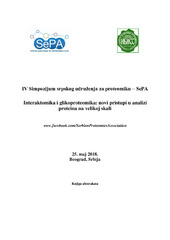Приказ основних података о документу
Digestomics of Japanese abalone in real food matrix
| dc.creator | Prodić, Ivana | |
| dc.creator | Khulal, Urmila | |
| dc.creator | Mutić, Jelena | |
| dc.creator | Mihailović, Jelena | |
| dc.creator | Smiljanić, Katarina | |
| dc.creator | Ćirković-Veličković, Tanja | |
| dc.date.accessioned | 2023-10-10T10:35:59Z | |
| dc.date.available | 2023-10-10T10:35:59Z | |
| dc.date.issued | 2018 | |
| dc.identifier.uri | http://intor.torlakinstitut.com/handle/123456789/774 | |
| dc.description.abstract | Objective: Haliotis discus (Japanese abalone), mollusks among various shellfish, is a highlynutritive food resource in the world, but also among the eight allergic food groups accounting forapproximately 90% of all immunoglobulin E food allergies worldwide. The general objective of ourresearch is to comprehensively investigate stability and structures of pepsin-resistant allergens, oftheir larger fragments, and of short digestion resistant peptides (SDRPs) released by pepsindigestion of whole raw and extract of shellfish, under standardized and physiologically relevantgastric conditions.Materials and Methods: Extract of raw whole shellfish (eRSS) and whole raw shellfish (wRSS),were pepsin digested according to standardized static digestion protocol. Controls were treated in asame manner without adding pepsin. Supernatant of samples and its counterpart controls wereprecipitated with TCA/acetone. Obtained proteins were assessed by 2D SDS PAGE and 1D SDS-PAGE, under reducing and non-reducing conditions. 1D SDS-PAGE of RSS were analyzed byncLC-MS/MS (Orbitrap LTQ) shot-gun proteomics. Relative quantification was performed by LFQalgorithm within Peaks 8.5 software package Bioinformatics Solutions Inc. (BSI), Waterloo,Canada.Results and Conclusion: 1D SDS-PAGE analysis of eRSS and wRSS, and its controls showed arange of proteins in varied concentrations between 10-250 kDa. In extracted and whole rawshellfish, approximately 22 prominent protein bands were observed including the distinct bandscorresponding with the molecular weights of recognized shellfish allergen, tropomyosin (37-39kDa). Fewer high molecular weight proteins were observed followed by protein smearing,specifically around the low molecular weight protein bands. The smearing could possibly be due tothe breakdown products and the glycation. There were slight differences between the proteinprofiles under reducing and non-reducing conditions as well. Nevertheless, there was the retentionof a band in the 37kDa molecular weight marker in all 4 samples, likely consistent with heat stabletropomyosin (TM). Mass spectrometry showed allergens that are characterized (Hal d 1 and Hal di1), with 90% of sequence homology with main tropomyosin allergens from seafood.Scientific impact and relevance: The results will highlight effects of food matrix on shellfishallergens digestibility proving its relevancy in molecular allergology. Moreover, an insight will beobtained on the differences in digestibility of allergenic versus non-allergenic tropomyosins in thereal food matrix. | sr |
| dc.language.iso | en | sr |
| dc.publisher | Srpsko Udruženje za Proteomiku, SePA; IBISS | sr |
| dc.relation | info:eu-repo/grantAgreement/MESTD/Basic Research (BR or ON)/172024/RS// | sr |
| dc.relation | info:eu-repo/grantAgreement/EC/FP7/256716/EU// | sr |
| dc.rights | openAccess | sr |
| dc.rights.uri | https://creativecommons.org/licenses/by/4.0/ | |
| dc.source | IV Simpozijum srpskog udruženja za proteomiku – SePA, Interaktomika i glikoproteomika: novi pristup u analizi proteina na velikoj skali, 25. maj 2018, Beograd, Srbija | sr |
| dc.subject | seashells | sr |
| dc.subject | Abalon | sr |
| dc.subject | tropomyosin | sr |
| dc.subject | food allergy | sr |
| dc.subject | food digestion | sr |
| dc.title | Digestomics of Japanese abalone in real food matrix | sr |
| dc.type | conferenceObject | sr |
| dc.rights.license | BY | sr |
| dc.citation.epage | 10 | |
| dc.citation.spage | 10 | |
| dc.description.other | Book of Abstracts | sr |
| dc.identifier.fulltext | http://intor.torlakinstitut.com/bitstream/id/1796/Digestomics_of_Japanese_pub_2018.pdf | |
| dc.identifier.rcub | https://hdl.handle.net/21.15107/rcub_intor_774 | |
| dc.type.version | publishedVersion | sr |

